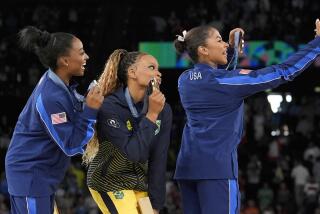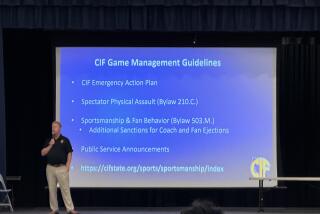Panel Seeks Fine-Tuning, Not Overhaul, of Title IX
WASHINGTON — Allaying fears that the Bush administration was planning to gut the federal government’s primary program for promoting women’s athletics, an advisory panel Thursday recommended a series of steps that would clarify the law known as Title IX, rather than take sweeping steps to revise it.
Ending a contentious two-day session that drew scattered protests, the panel, which will present a report to Education Secretary Roderick R. Paige next month, emerged with a message acknowledging that the 30-year-old landmark policy has changed the face of high school and college sports by dramatically increasing women’s participation but noting that there is room to improve how it is applied.
Advocates of women’s sports came away pleased that the law, part of the Education Amendments of 1972, would remain largely intact.
“I think it’s fair to say I’m relieved,” said Betsy Stevenson, associate athletic director at UCLA.
Supporters of men’s low-profile sports, such as wrestling, were disappointed that substantive changes in determining how schools can comply with the policy were not recommended, but said they were pleased that the issues were being presented in a high-profile public forum.
“I think the White House will be encouraged by the broad-based consensus that there needs to be a change,” said Mike Moyer, executive director of the National Wrestling Coaches Assn. “There may be differing opinions about what that change should be ... but this is a great first step and a great opportunity for a lot of reasonable debate.”
Like many issues involving allegations of discrimination, this one is likely to end up being decided in the courts.
Last January, associations of college wrestling, gymnastics, track and field and swimming coaches filed a lawsuit against the Department of Education, challenging the standard of “substantial proportionality,” which many schools use to show compliance with Title IX.
Paige formed the commission in response to the suit, which is being heard before the U.S. District Court in Washington.
Though any changes in the language of Title IX must be approved by Congress, Paige can interpret how compliance is measured, and he will decide which, if any, of the committee’s recommendations to adopt.
For the most part, the commission seemed to produce 25 recommendations of artful compromise devoid of any sweeping proposals that might threaten the law. Yet it asserted that colleges should not be forced to cut back men’s teams to narrow the gap between male and female athletic programs, signaling to the Bush administration that Title IX has not been fair to all.
“Title IX is a public treasure ... it changed our values, the way we look at women, it’s been wonderful. But it is time to look at how it is enforced,” said Ted Leland, director of athletics at Stanford and co-chair of the 15-member panel.
Schools can comply with Title IX in one of three ways. The most popular, and most controversial, is the proportionality standard that requires athletic opportunities to reflect campus enrollment: If 55% of the student body is female, for example, then close to 55% of the athletic spots should go to women.
Across the country, a number of coaches and athletic directors were hoping for revisions to that standard, which critics have derided as a “quota” system. At Loyola Marymount, where 59% of the enrollment is female, coaches of some men’s teams are given roster caps, while women’s coaches have a minimum roster figure they must maintain, Athletic Director Bill Husak said.
For example, he said, the baseball team cuts interested men every year to stay at a maximum roster of 32. Meanwhile, the softball and rowing teams have trouble getting enough women to fill their minimum rosters of 20 players and 38 rowers. “The crew coach would walk the dorms and slide fliers under the doors to find more women,” he said.
After much debate Thursday, the divided panel stopped well short of eliminating the proportionality standard, then rejected a series of proposals to substantially alter it. Instead, it suggested that non-scholarship walk-on male athletes be taken out of the proportionality equation. That would allow men’s teams to add athletes to their rosters without the school’s needing to add female athletes to balance the books. It was also unanimously recommended that the fundamental rule of Title IX be more clearly spelled out and that schools be given more flexibility in meeting the standard.
That came as a disappointment to some in the audience.
“Everybody loses if they don’t do away with the proportionality quota,” said Brian Christin, assistant wrestling coach at Good Counsel High in Maryland. “Title IX should mandate equal opportunity, not mandate equal outcome. It’s just not fair.”
The audience was filled with athletes and other interested parties, but neither they nor the commissioners claimed to fully understand the potential impact of the recommendations.
One proposal would have given schools 7% “wiggle room” in showing that their athletic opportunities were in proportion to enrollment, which could have cost hundreds of thousands of high school slots for girls. The commission settled instead on a standard of “reasonable” flexibility, but no one knew exactly what that meant.
The panel suggested that athletic opportunities be based not only on the number of women enrolled, but on the numbers of women actually interested in participating -- a factor that could be measured with student surveys.
The commissioners also proposed making it easier for schools to show compliance with Title IX by one of the other factors already present in the law: pointing to the history of opportunities provided to women or the record for meeting the interests and abilities of women who wish to compete. Most schools have chosen to use proportionality, instead, because numbers are a straightforward measure and the criteria for the other two are unclear.
But the details aside, the panel’s overarching message -- that Title IX needs work -- resonated more loudly than the particulars of what that work should be.
“There is dialogue for the first time, and it is long overdue,” said Eric Pearson, chairman of the College Sports Council, a Washington-based organization that is a party to the coaches’ lawsuit. “People on the front lines of this law have all been able to comment on how it’s affecting their lives. The way it is now, male athletes will be hurt more than women are advanced.”
That Title IX seemed to emerge from the process largely unthreatened was accomplishment enough for some.
“This is a victory for all the women who have paved the way to have Title IX enforced,” said Becky Heidesch, chief executive of Women’s Sports Services, a consulting firm in Huntington Beach.
But others believed that even minor tinkering by the panel boded ill for the future of women’s and girls’ athletics. If the opportunity to play is curtailed, they fear, interest in sports will never have the chance to be nurtured.
“What they have approved would radically restructure current Title IX policies and would significantly disadvantage women and girls,” said Jocelyn Samuels, vice president and director of educational opportunities at the National Women’s Law Center in Washington.
Among those who would have agreed was 10-year-old Victoria Thompson, an avid softball and basketball player thanks to Title IX. She sat with her father in the audience, their backs to the commissioners.
“They turned their back on us, so we’ve turned ours on them,” John Thompson said.
*
Times staff writer Rob Fernas contributed to this report.
More to Read
Go beyond the scoreboard
Get the latest on L.A.'s teams in the daily Sports Report newsletter.
You may occasionally receive promotional content from the Los Angeles Times.










